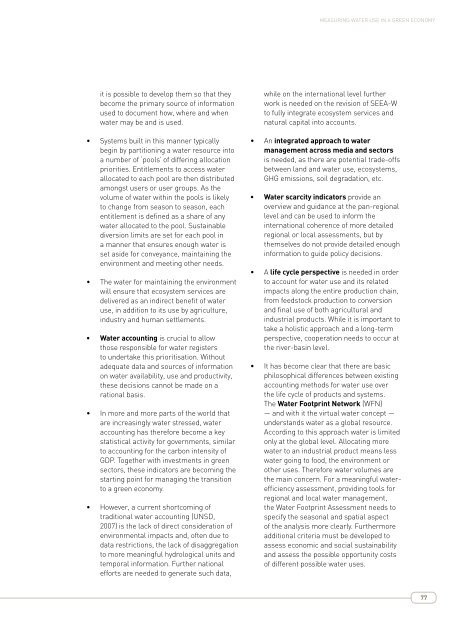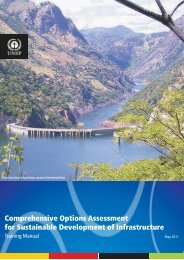MEASURING WATER USE IN A GREEN ECONOMY - UNEP
MEASURING WATER USE IN A GREEN ECONOMY - UNEP
MEASURING WATER USE IN A GREEN ECONOMY - UNEP
Create successful ePaper yourself
Turn your PDF publications into a flip-book with our unique Google optimized e-Paper software.
Measuring water use in a green economy<br />
it is possible to develop them so that they<br />
become the primary source of information<br />
used to document how, where and when<br />
water may be and is used.<br />
• Systems built in this manner typically<br />
begin by partitioning a water resource into<br />
a number of ‘pools’ of differing allocation<br />
priorities. Entitlements to access water<br />
allocated to each pool are then distributed<br />
amongst users or user groups. As the<br />
volume of water within the pools is likely<br />
to change from season to season, each<br />
entitlement is defined as a share of any<br />
water allocated to the pool. Sustainable<br />
diversion limits are set for each pool in<br />
a manner that ensures enough water is<br />
set aside for conveyance, maintaining the<br />
environment and meeting other needs.<br />
• The water for maintaining the environment<br />
will ensure that ecosystem services are<br />
delivered as an indirect benefit of water<br />
use, in addition to its use by agriculture,<br />
industry and human settlements.<br />
• Water accounting is crucial to allow<br />
those responsible for water registers<br />
to undertake this prioritisation. Without<br />
adequate data and sources of information<br />
on water availability, use and productivity,<br />
these decisions cannot be made on a<br />
rational basis.<br />
• In more and more parts of the world that<br />
are increasingly water stressed, water<br />
accounting has therefore become a key<br />
statistical activity for governments, similar<br />
to accounting for the carbon intensity of<br />
GDP. Together with investments in green<br />
sectors, these indicators are becoming the<br />
starting point for managing the transition<br />
to a green economy.<br />
• However, a current shortcoming of<br />
traditional water accounting (UNSD,<br />
2007) is the lack of direct consideration of<br />
environmental impacts and, often due to<br />
data restrictions, the lack of disaggregation<br />
to more meaningful hydrological units and<br />
temporal information. Further national<br />
efforts are needed to generate such data,<br />
while on the international level further<br />
work is needed on the revision of SEEA-W<br />
to fully integrate ecosystem services and<br />
natural capital into accounts.<br />
• An integrated approach to water<br />
management across media and sectors<br />
is needed, as there are potential trade-offs<br />
between land and water use, ecosystems,<br />
GHG emissions, soil degradation, etc.<br />
• Water scarcity indicators provide an<br />
overview and guidance at the pan-regional<br />
level and can be used to inform the<br />
international coherence of more detailed<br />
regional or local assessments, but by<br />
themselves do not provide detailed enough<br />
information to guide policy decisions.<br />
• A life cycle perspective is needed in order<br />
to account for water use and its related<br />
impacts along the entire production chain,<br />
from feedstock production to conversion<br />
and final use of both agricultural and<br />
industrial products. While it is important to<br />
take a holistic approach and a long-term<br />
perspective, cooperation needs to occur at<br />
the river-basin level.<br />
• It has become clear that there are basic<br />
philosophical differences between existing<br />
accounting methods for water use over<br />
the life cycle of products and systems.<br />
The Water Footprint Network (WFN)<br />
— and with it the virtual water concept —<br />
understands water as a global resource.<br />
According to this approach water is limited<br />
only at the global level. Allocating more<br />
water to an industrial product means less<br />
water going to food, the environment or<br />
other uses. Therefore water volumes are<br />
the main concern. For a meaningful waterefficiency<br />
assessment, providing tools for<br />
regional and local water management,<br />
the Water Footprint Assessment needs to<br />
specify the seasonal and spatial aspect<br />
of the analysis more clearly. Furthermore<br />
additional criteria must be developed to<br />
assess economic and social sustainability<br />
and assess the possible opportunity costs<br />
of different possible water uses.<br />
77

















